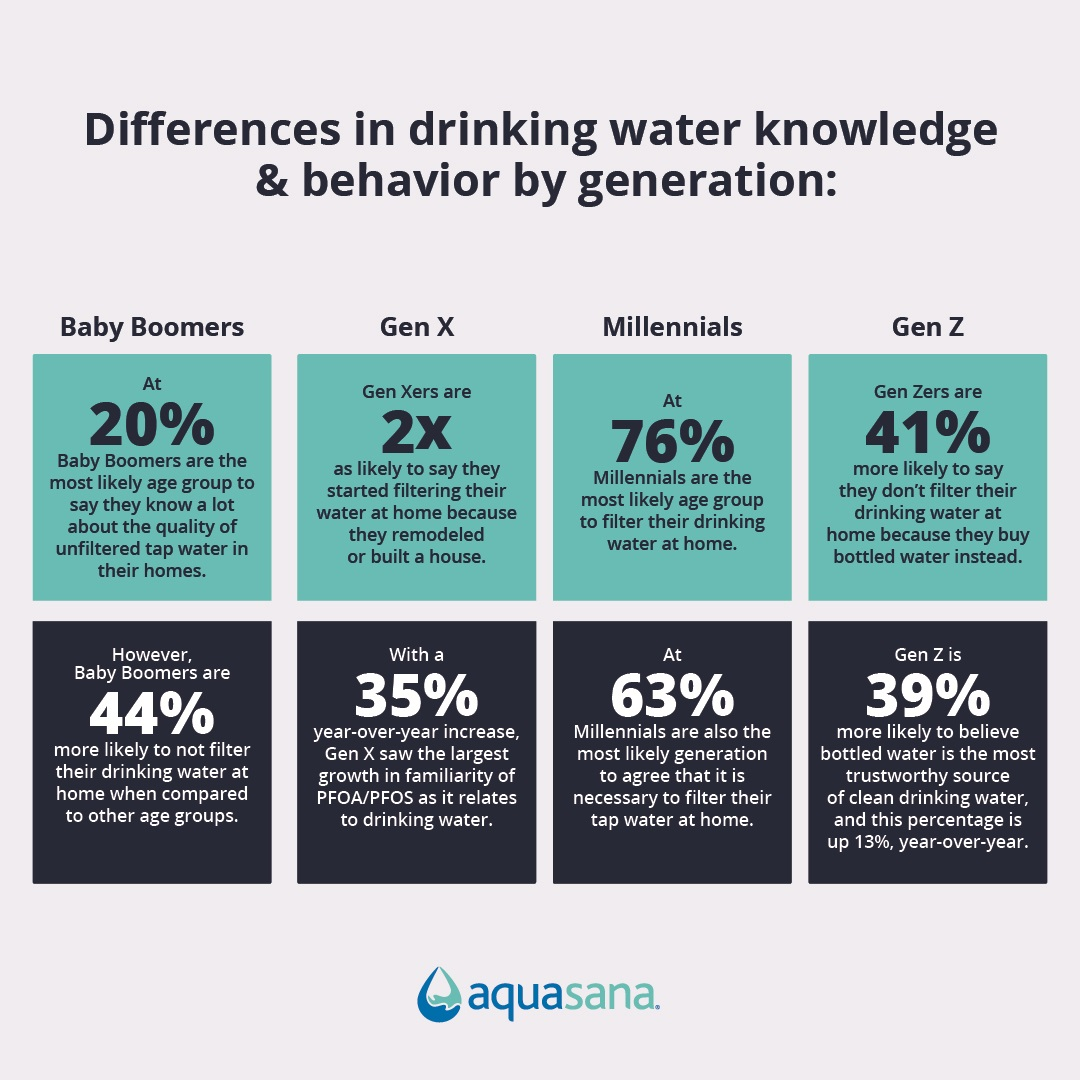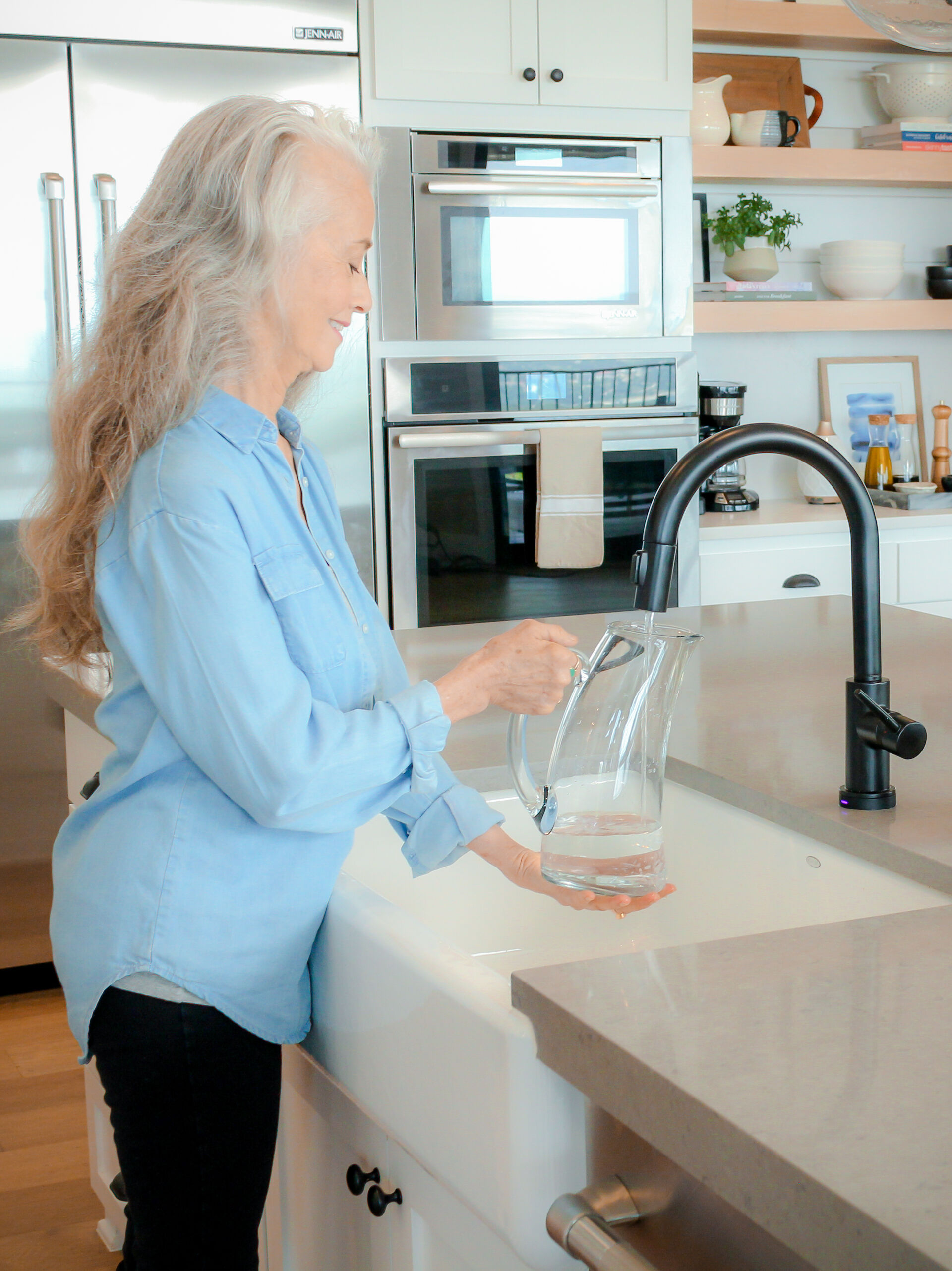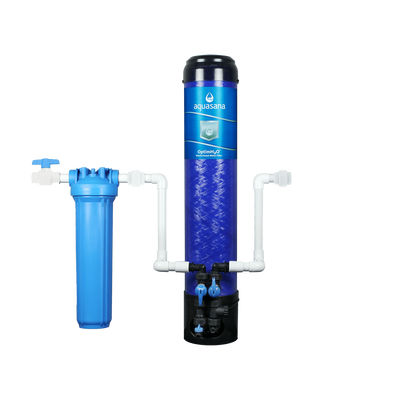Gen X continues to show interest and concern regarding water quality
According to the survey, members of Generation X (people born from 1965 to 1980) are filtering their water more in 2021 than 2020. Additionally, familiarity with the “forever chemicals” PFOA/PFOS contaminants grew more among Gen Xers year-over-year than any other age group.
Nearly three-quarters of Gen X adults in the U.S. filter their water at home (73%). When it comes to the type of filter, Gen Xers are the most likely to fill up using the built-in water filter in their refrigerator, and the least likely to use a water filter pitcher or faucet filter than any other age group.
This year’s survey also uncovered some interesting shifts in concern over specific water contaminants that have occurred over the past year, including PFOA/PFOS, lead, bacteria, viruses, and more. For example, Gen X’s familiarity with PFOA/PFOS as it relates to water was up 35% compared to 2020, marking the largest increase of any age group.
Overall, the top three water contaminants that concern Gen X adults the most are:
- Bacteria, Cysts & Viruses (27%): Up 50% from 2020
- Lead (25%): Down 17% from 2020
- Chlorine/Chloramines (15%): Down 12% from 2020
The number of Gen Xers who cited bacteria, cysts, and viruses as their primary contaminant of concern jumped up 50% from February 2020, marking the most notable shift. This is not surprising considering the overall growth of public fear and anxiety toward viruses and disease, particularly COVID-19, since the 2020 survey responses were collected. This also explains why historically dominant contaminants of concern like lead and chloramines dropped slightly in comparison.
Millennials are most likely to agree it’s necessary to filter their drinking water at home and take action
Millennials (people born from 1981 to 1996) are uniquely tuned in to the quality of their tap water. According to the survey, they are more likely to agree (63%) that it's necessary to filter their drinking water at home than any other generation, and they’re also the most likely to take action on it.
In fact, 76% of Millennials say they filter their water at home, compared to 71% of U.S. adults in all other age groups. Not surprisingly, they’re also more knowledgeable on water quality issues, including harmful contaminants. For example, Millennials are 42% more likely than other generations to be familiar with the “forever chemicals” PFOA/PFOS as they relate to water. Awareness of these toxic chemicals will likely continue to grow across generations as they receive widespread, national media attention. For example, just last June, reports of PFAS-contaminated rain across the Midwest made news headlines and stunned the nation.
The COVID-19 pandemic has also impacted how Millenials feel about their drinking water quality. According to this year’s survey, Millennials were the most likely age group (22% more likely than others) to say spending more time at home because of COVID-19 made them more concerned about the quality of their tap water.
The surprising water bottle habits of Gen Zers
The 2021 Aquasana Water Quality Survey revealed that members of Generation Z (people born from 1997 to 2012) have a surprisingly high level of trust and consumption when it comes to drinking bottled water. This is despite the fact that bottled water is actually less regulated than municipal water, and it contributes to the 30 million+ tons of plastic that’s discarded in America each year.
Gen Z is more likely to trust and drink bottled water than any other age group. What's more, the number of Gen Zers who say they don't bother filtering their water at home because they're turning to bottled water instead is growing and jumped up by 87.5% from 2020.
When asked why they increased their purchase of bottled water, 39% of Gen Zers said it was simply for convenience. However, the increase in bottled water consumption is likely also linked to this generation’s false sense of perceived trust. The majority (53%) of Gen Z believes bottled water is the most trustworthy source of drinking water, and they are 39% more likely to say this than other generations. Furthermore, the percentage of Gen Zers who cited bottled water as the most trustworthy source of drinking water is actually up 13% year-over-year, a stark contrast with the 5% decline for all generations combined.
In reality, bottled water companies are not held to the same standards as public water municipalities which means tap water may actually be safer. Bottled water companies are not required to disclose where the water came from, how it was treated, and what contaminants it contains. Furthermore, the Environmental Working Group performed a study and found 38 contaminants across 10 major bottle brands, including cases where contaminant levels exceeded legal limits.
COVID-19 has also impacted how Gen Zers feel about the quality of their water. In fact, compared with other generations, they were the most likely age group to say they increased the amount of bottled water they purchased because of the pandemic (34% vs. 29%).
According to a recent Pew Research study, Gen Zers are talking more about the need for action on climate change, compared to older adults. Known for their predilection toward climate activism, this generation is seen to be more health-conscious, socially aware, and environmentally responsible. That’s why their increased consumption of bottled water, more than any other age group, is surprising given its devastating environmental impact.
Research shows the water bottling process releases 2.5 million tons of carbon dioxide into the atmosphere annually, and 38 billion disposable bottles end up in U.S. landfills each year. While Gen Zers may continue purchasing bottled water for now, they also show a strong desire to make lifestyle changes in order to be more environmentally friendly, which would indicate a transition away from bottled water at some point.
For any Gen Zers looking for a clean, healthy, and eco-friendly alternative to bottled water, we recommend bottling your own using a high-quality water filter such as a whole house, under sink, or countertop system.

Notable takeaways
Overall, the 2021 Aquasana Water Quality Survey made it clear that each generation has its own unique set of beliefs and behaviors when it comes to water quality. We discovered that while Baby Boomers claim to be the most knowledgeable age group about their tap water, they’re actually the least likely to filter it. In contrast, Millennials are actually the most knowledgeable about water quality and are also the most likely to use a water filter. Finally, resourceful and independent Gen Xers impressed with greater knowledge about emerging water contaminants such as PFOA/PFOS. And surprisingly, Gen Zers — known for their climate action enthusiasm — showed the highest level of trust and consumption of bottled water bottles, though we expect that to decline in the future.
Everyone deserves to have access to clean and healthy drinking water, regardless of generation. If you’re looking to improve the taste, quality and overall health of the water in your home — check out our wide selection of award-winning water filtration products or contact our water experts to learn more.

Survey methodology and definitions
The findings presented in this article are the result of a March 2021 study of 2,143 U.S. adults, ages 18-79, conducted by Aquasana. (Confidence Level: 95%, Margin of Error: 2%)
Survey methodology
The findings presented in this article are the result of a March 2021 study of 2,143 U.S. adults, ages 18-79, conducted by Aquasana. (Confidence Level: 95%, Margin of Error: 2%)
Survey definitions
Age Cohorts (based on Pew Research)
-Baby Boomers: 1946-64
-Gen X: 1965-80
-Millennials: 1981-96
-Gen Z: 1997-2012
Regions (based on U.S. Census map)
-Northeast: Maine, Massachusetts, New Hampshire, New Jersey, New York, Pennsylvania, Rhode Island, Vermont, Connecticut
-Midwest: Illinois, Indiana, Iowa, Kansas, Michigan, Minnesota, Missouri, Nebraska, North Dakota, Ohio, South Dakota, Wisconsin
-South: Alabama, Georgia, Kentucky, Louisiana, Maryland, Mississippi, North Carolina, Oklahoma, South Carolina, Arkansas, Tennessee, Texas, Virginia, West Virginia, Delaware, Florida
-West: Idaho, Alaska, Montana, Nevada, Arizona, New Mexico, Oregon, Utah, Washington, Wyoming, California, Colorado, Haw
Urban, Suburban, and Rural Classifications
-The urban, suburban, and rural classifications we use are based on the database and definitions from Great Data, which developed their logic using U.S. Census data.




